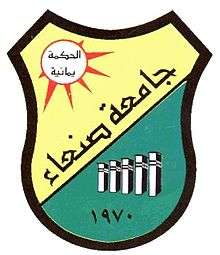Sana'a University
| جامعة صنعــاء | |
 | |
| Type | Public |
|---|---|
| Established | 1970 |
| President | Dr. Abdalkareem Alshargabi |
| Students | around 8,000-14,000 every year |
| Location | Sana'a, Yemen |
Sana'a University (Arabic: جامعة صنعــاء) was established in 1970 as the first and the primary university in the Yemen Arab Republic (North Yemen), now the Republic of Yemen (see also Aden University). It is located in Sana'a, the capital of Yemen, and is currently organized with 17 faculties. Previously the university was located at 15°20′53.16″N 44°11′26.83″E / 15.3481000°N 44.1907861°E, and was built on the grounds of the old Jewish cemetery.
Overview
When Sana'a university was first established, it had two faculties: the Faculty of Sharia and Law and the Faculty of Education, which also included the specialties of Colleges of Arts, Sciences and Education. In 1974, those specialties were developed and formed three new faculties: Arts, Science, Education. The Faculty of Sharia and Law celebrated the launch of the Business Department, which became an independent faculty a year later. By that time, the university included five faculties and continued expansion until it included the rest of the other specialties. In 2000, the university included 17 faculties, ten of which were in Sana'a including all types of academic specialties; the rest were spread around the country.
Faculties
- Faculty Of Engineering
- Faculty Of Computer & Information Technology
- Faculty Of Commerce & Economics
- Faculty Of Medicine
- Faculty Of Dentistry
- Faculty Of Pharmacy
- Faculty Of Science
- Faculty Of Agriculture
- Faculty Of Law & Legislation
- Faculty Of Education
- Faculty Of Art
- Faculty Of Languages - ru
- Faculty Of Publication
- Faculty Of Education - Mahout
- Faculty Of Education - Khaulan
- Faculty Of Education - Marib
- Faculty Of Education - Arhab
Notable faculty
Notable alumni
- Hamid al-Ahmar, politician
- Yahya Al-Mutawakel, Minister of Industry and Trade
- Hoda Ablan, poet
- Abdulla A. Alshammam, ambassador to Netherlands, earned a graduate degree in political science in 1982/1983. A Yemeni diplomat,[6] he works at the Ministry of foreign affairs,[7] ambassador.
- Tawakel Karman earned a graduate degree in Political Science.[8][9] She was awarded the 2011 Nobel Peace Prize. She is the first Yemeni citizen and first Arab woman to win a Nobel Prize
- Ahmed Mohammed, politician
- Maha Naji Salah,
- Zeyad Ghanem, poet, politician
References
- ↑ Raghavan, Sudarsan (December 10, 2009). "Cleric linked to Fort Hood attack grew more radicalized in Yemen". Washington Post. Retrieved December 10, 2009.
- ↑ Shane, Scott (November 18, 2009). "Born in U.S., a Radical Cleric Inspires Terror". New York Times. Retrieved November 20, 2009.
- ↑ Holmes, Oliver (November 5, 2009). "Why Yemen Hasn't Arrested Terrorist Cleric Anwar al-Awlaki". TIME. Retrieved November 11, 2010.
- ↑ Warren Richey (August 31, 2010). "Anwar al-Awlaki: ACLU wants militant cleric taken off US 'kill list'". Christian Science Monitor. Retrieved October 30, 2010.
- ↑ UPI staff reporter (November 11, 2009). "Imam in Fort Hood case born in New Mexico". United Press International. Retrieved November 13, 2009.
- ↑ http://www.undemocracy.com/Yemen/al-shammam
- ↑ http://www.un.org/News/Press/docs/1996/19960325.l2761.html
- ↑ Agence France Presse. "Tawakkol Karman, figure emblématique du soulèvement au Yémen." NordNet, 7 October 2011. Retrieved 11 October 2011 nordnet.fr.
- ↑ C. Jacobs. 24 Oct 2011. "Nobel Peace Prize Laureate Tawakkul Karman – A Profile." Middle East Research Institute, Inquiry & Analysis Series Report No.752. Retrieved 24 October 2011 MEMRI
External links
| Wikimedia Commons has media related to Sanaa University. |
Sources
- Sana'a University, website.
- Matriculation guide booklet - Sana'a University, annually revised in Arabic for advanced students.
Coordinates: 15°21′54.33″N 44°11′4.08″E / 15.3650917°N 44.1844667°E